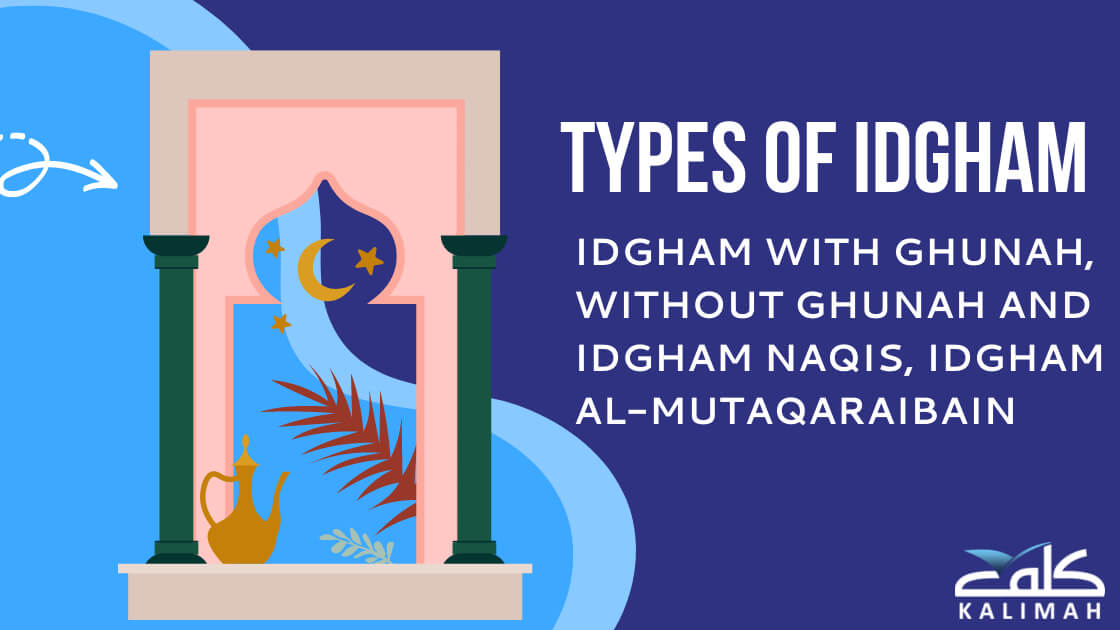Now, after we had identified Idgham and learned the letters that form it, let’s talk about its kinds with simple models. How many kinds of Idghaam are there? There are two kinds of Idgham, they are as follows:
- Idgham with Ghunnah
- Idgham without Ghunnah
- Idgham Mutaqaraibain
- Idgham Naqis
Idgham, a Tajweed concept, encompasses various assimilation rules in Quranic recitation. It includes Idgham with Ghunna, where a non-nasal sound merges with a nasal sound, marked by a nasalization and prolongation. Idgham without Ghunna involves assimilating a nasal sound into a non-nasal sound without prolongation, typically marked by a small vertical line.
Idgham Mutaqaraibain occurs when similar letters are close in articulation, merging the preceding letter into the following one. Lastly, Idgham Naqis involves a short assimilation where the first letter is inserted into the second rather than dropped completely. These rules ensure smooth and melodious Quranic recitation.
1. Idgham With Ghunna
Idgham With Ghunna is the first type of Idgham, which is called Idgham with nasalization (Ghunnah). Ghunnah is a sound that comes out of our noses.
Idgham with Ghunnah is assimilated into a non-nasal sound, and the nasal sound is prolonged for one vowel count. This is accompanied by a slight nasalization of the sound. This type of idgham is marked with a small circle above the non-nasal letter.
The duration of the Ghunah is approximately two seconds or two beats. Idgham with Ghunnah happens when some specific Idgham letters come with An-noon Es-Sakinah or At-Tanween which include the letters of the word يَنْمُو:
| و | م | ن | ي |
These letters are called letters of Idgham with Ghunnah.
If any letter of these four letters comes after An-NoonEs-Sakinahor At-tanween, then both of An-noon Es-Sakinah or At-tanween sound will be hidden, and the letter that comes before An-noon As-sakinah or the letter that is having At-tanween will merge with the letter of Idgham.
In this case, Ghunnah will be present, so the one who is reciting the Holy Quran has to place the stress on the two letters that mixed a new sound.
Examples of Idghaam with Ghunnah
Here are some Examples of Idgham with Ghunnah of:
(وَجَعَلْنَا سِرَاجًا وَهَّاجًا)
Surah An-Naba:13).
In this case, the letter (و ) in the word وَهَّاجًا came after the At-tanween and its sound hides the sound of the letter (جً) which is joined with the letter waw و. Whereas the letter (أ) at the end of the word سِرَاجًا became unclear in this verse or become a letter with Idgham with Ghunah.
Another example for this verse is:
جَزَاءً مِّن رَّبِّكَ عَطَاءً حِسَابًا
Surah An-Naba, verse number, 36.
In this example, At-tanween in the word جَزَاءً is followed by the letter (مِ ), So, Idgham with Ghunnah should be given. In this case, the reader should utter Ghunnah by putting stress on the new sound of the two letters, he should decrease the normal sound of At-tanween, Also El-Hamza should be joined with the Arabic letter (Meem).
Another example ofIdgham is the following:
وَمِنَ النَّاسِ مَنْ يَقُولُ آمَنَّا بِاللَّـهِ وَبِالْيَوْمِ الْآخِرِ وَمَا هُمْ بِمُؤْمِنِين”
Surah Al-Baqarah verse, 8.
In this verse, the letter (يَ) in the word يَقُولُ, which is one of the letters of Idgham with Ghunnah, Comes after An-noon Es-Sakinah in the word مَنْ.
Consequently, the reader should place stress on the new sound that is formed by joining of the letter Meem with the letter Yaa, as An-noon Es_sakinah was concealed and there is the new sound produced.
2. Idgham Without Ghunnah
Idgham without Ghunnah is the nasal sound that is assimilated into a non-nasal sound without prolonging the nasal sound. This type of idgham is marked with a small vertical line above the non-nasal letter.
There are two letters of the six Idgham letters that are without Ghunnah, they are Laam (ل and Raa (ر).
When any of these letters come before An-noon Es-sakinah, then An-noon As-sakinah would be concealed, and the letter that comes after An-noon Es-Sakinah would be attached to either the letter ل( Laam) or the letterر(Raa).
In case if the letter لorرcome after At-tanween, then the reader should articulate the sound (n) that arises because At-tanween is present.
Examples of Idghaam without Ghunnah
Here are some Examples of Idgham without Ghunnah from the Holy Quran:
فَإِنِ انْتَهَوْا فَإِنَّ اللَّـهَ غَفُورٌ رَحِيمٌ
(Surah Al-Baqarah, verse number 192)
In this example, since At-tanween in the word غَفُورٌ is followed by the letter ر (Raa) in رَحِيمٌ, then At-tanween should be concealed and read with the Arabic phonetic sign Dummah with merging it with the next letter.
So it should not be pronounced as (Ghafoorun Raheem) instead, it should be pronounced without Ghunnah as (Ghafoor-ur-Raheem).
Here is another example:
أُولَـٰئِكَ عَلَىٰ هُدًى مِنْ رَبِّهِمْ ۖ وَأُولَـٰئِكَ هُمُ الْمُفْلِحُونَ
( Surah Al-Baqarah verse num,5
In this example, An-noon Es-Sakinah in “منْ” is followed by the letterر (Raa) in the word رَبِّهِمْ. So the letter Raa will be concealed completely. And The letter that is before An-noon Es-sakinah which is م (Meem) will be merged intoر(Raa), So the phrase will be pronounced as (Mir–Rabbihim) instead of (Min Rabbihim).
(Read the full discussion of The rules of Raa in this article)
وَمَنْ أَضَلُّ مِمَّنْ يَدْعُو مِنْ دُونِ اللَّـهِ مَنْ لَا يَسْتَجِيبُ لَهُ إِلَىٰ يَوْمِ الْقِيَامَةِ
(Al-Ahqaf:5)
In this verse, An-noon Es-Sakinah will be concealed as it is followed by the letter ل (Laam). It will be pronounced (Mallaa), instead of pronouncing it as (Man–Laa).
Contact us with your answer and check the correct pronunciation.
3. Idgham Mutaqaraibain المُتَقَارِبَين:
The rule of Idgham Mutaqaraibain happens when two similar letters come one after the other. The place of articulation (Makhraj) of the two letters is close to each other in the mouth. So, this is the reason for its name Mutaqaribain which means close to each other.
The letter that comes first is with skoon (Arabic phonetic sign) and the letter that follows has the phonetic sign Shaddah. If the following letter has a Shaddah, then the letter that came before it should be merged into it to form a new sound.
Idgham Mutaqaribain Examples
| إِنَّ اللَّهَ سَمِيعٌ بَصِيرٌ | The idgham of the Tanween on the Ayn letter with the letter baa (ب) that follows it. |
| يَا بُنَيَّ ارْكَبْ مَعَنَا | The Idgham of the letter Baa in اركب with the following letter meem. |
| وَقُلْ رَّبِّ | The Idgham of the letter Lam with the letter Raa that follows it. |
| وَلَا تَكُنْ مَعَ الْكَافِرِينَ | The Idgham of the letter noon in the word تَكُنْ with the letter Meen that follows it. |
4. Idgham Naqis
Idgham naqis linguistically means a short Idgham. But we have to know first Idgham Kamal (full) in order to understand what is meant by idgham naqis.
Idgham Kamal is when we completely hide the letter that comes first and utter just the letter that follows it, so that they become one fully stressed letter, this case occurs with just four letters of Idgham letters, namely:
| ن | ل | م | ر |
Here is an example:
مِّن لَّبَنٍ
Whereas idgham naqis is when we insert (not drop) the first letter into the second letter such as the letters of ط ت:
Example of Idgham Naqis
Here is an example:
فَمَكَثَ غَيْرَ بَعِيدٍ فَقَالَ أَحَطْتُ بِمَا لَمْ تُحِطْ بِهِ وَجِئْتُكَ مِنْ سَبَإٍ بِنَبَإٍ يَقِين
Surah An-name, verse 22
The Short idgham of the word أَحَطْتُ between the letter ط and the letter ت. Where the reciter does not drop the words completely, rather they are slightly or shortly joined together.
🌟 Unlock Your Potential in Arabic and Quran with Kalimah Center! 🌟
Ready to deepen your connection with the Quran and enhance your understanding of Arabic? Join Kalimah Center today and embark on a transformative journey of learning and growth! Our professional, handpicked Online Arabic and Quran Tutors are dedicated to helping you master these essential skills with ease and expertise.
📚 Explore Our Courses:
Online Arabic Course: Tailored to your level, our comprehensive Arabic program includes 16 teaching levels and 400+ hours of personalized sessions.
Online Quran With Tajweed Course: Perfect for non-Arabic speakers, our course spans 13 levels and equips you with Tajweed mastery from beginner to advanced.
Online Arabic Course For Kids: Nurture your child’s love for Arabic with our engaging and structured program, available in 24 levels for primary, intermediate, and secondary stages.
💡 Why Choose Kalimah?
Expert Tutors: Learn from native Arabic speakers and Ijazah-certified teachers who prioritize your progress.
Flexible Learning: Enjoy one-on-one classes, 24/7 access to materials, and interactive exercises for a dynamic learning experience.
Comfortable Environment: Benefit from a supportive and encouraging atmosphere, where mistakes are seen as opportunities for growth.
Proven Success: With over 8,000 students worldwide and glowing testimonials, Kalimah Center is your trusted partner in Arabic and Quran education.
🚀 Start Your Free Trial Today! 🚀
Don’t miss out on this life-changing opportunity to deepen your faith and knowledge. Sign up now for your free trial and take the first step towards becoming a better practicing Muslim with Kalimah Center!
Conclusion:
Idgham in Tajweed includes rules like Idgham with Ghunna, where a nasal sound merges with a non-nasal one, and Idgham without Ghunna, which assimilates a nasal sound without prolongation. Idgham Mutaqaraibain merges similar letters closely articulated, while Idgham Naqis involves short assimilation without dropping the first letter. These rules ensure smooth Quranic recitation.














